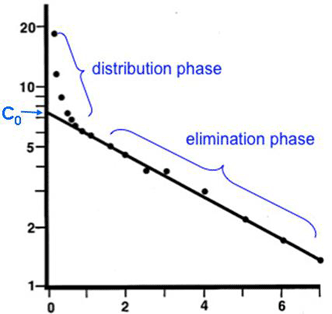How would you go about trying to measure the total volume of blood in the human body?
There is one simple solution to this question. Slash open someone at a major blood vessel and drain the blood into a bucket. Once all the blood has drained from the body, measure its volume.
But suppose, as most doctors strive to do, we want to keep the person alive, how could we measure the volume of their blood then?
Measuring fluid compartment volume
If there is a standard compartment of fluid, filled with an unknown volume, the theory of determining this volume is extremely straightforward.
If a known amount of substance A (in moles) is added to this unknown volume, V (in litres) then the concentration, C (in moles per litre) of the substance A can be used to work out the unknown, V. The concentration in the compartment can be easily measured and is given by the equation:
C = A/V
Since we now know C and A, by rearranging we can get the equation:
V = A/C
We have worked out our unknown volume!
Sadly, in the body, things are rarely this straightforward. In order for this method (known as the single dilution method) to work to calculate total blood volume, A must:
- Be restricted to a single compartment = not leave the blood
- Distribute evenly throughout the blood
- Not change over time = be excreted or metabolised
- Be non-toxic
- Be measured easily
- Not change V itself
It is extremely difficult to find a substance that meets all criteria. For example, a substance that is not excreted or metabolised is likely to be very toxic to the body. Nonetheless, there are a few methods that can be used to overcome some of these problems.
Single injection method
If you measure the concentration of a substance as soon as it has been injected, it will not have been excreted or metabolised by the body. However, the substance would not have spread evenly throughout the body and the concentration measurement would be far from accurate. But if you wait for the substance to be evenly distributed, some of it will be excreted or metabolised. Either way, we have a problem, either the concentration reading is going to be wrong, or the amount value is going to be wrong.
For a substance that is excreted or metabolised slowly the average concentration can determined by extrapolation back from a graph displaying the decrease in concentration over time (figure 2).

figure 2. Log(concentration) vs Time graph
The value of C0 given in figure 2 is actually the log10 of the initial concentration. By doing 10C0 we get the concentration C to use in our equation.
Constant perfusion method
If the excretion of the substance is quick, but occurs through a single route that we can monitor, this method is appropriate.
It works by infusing a substance at a constant rate, after an initial bolus, until the concentration of the substance in the blood is the same. Infusion is then ceased, and the amount of substance that is excreted is recorded. The volume is then calculated by:
V = amount excreted / concentration in plasma
The use of blood volume measurements can be of clinical importance for patients with congestive heart failure, chronic hypertension and renal failure. Thankfully, the methods above are at the disposal of medical professionals. It would not be helpful if a doctor had to hack their patients apart in order to measure their blood volume!
This is a common lateral thinking problem that comes up in admissions interviews. Having the skills to navigate a problem like this in an interview setting is extremely difficult, but hopefully through reading this post, you are prepared to not only tackle a question like this, but other questions in a logical manner.
References:
Single injection method
Blood volume
Fluid physiology

I absolutely LOVED the way you started this post! Thanks again for the knowledge!
Thanks, glad you enjoyed it!
Instead of measuring it, i'd prefer it all just stay where it is frankly (-:
What if this measurement is necessary for a diagnosis?
Good post my friend
It looks very logical, at the end of the day. How long does it take, in general? I mean, in case of emergency, is there a way to get quickly access to the information?
Both of the methods used take quite a while. I know the constant perfusion method can take up to 4 hours. In an emergency quicker diagnostic test are used to identify the problem, like using specific blood markers from a blood test. Although these values may not always be the most accurate, the speed with which they can be obtained is useful in deciding how to proceed in an emergency.
Congratulations @ovij! You have completed some achievement on Steemit and have been rewarded with new badge(s) :
Click on any badge to view your own Board of Honor on SteemitBoard.
For more information about SteemitBoard, click here
If you no longer want to receive notifications, reply to this comment with the word
STOPupvoted my friend.